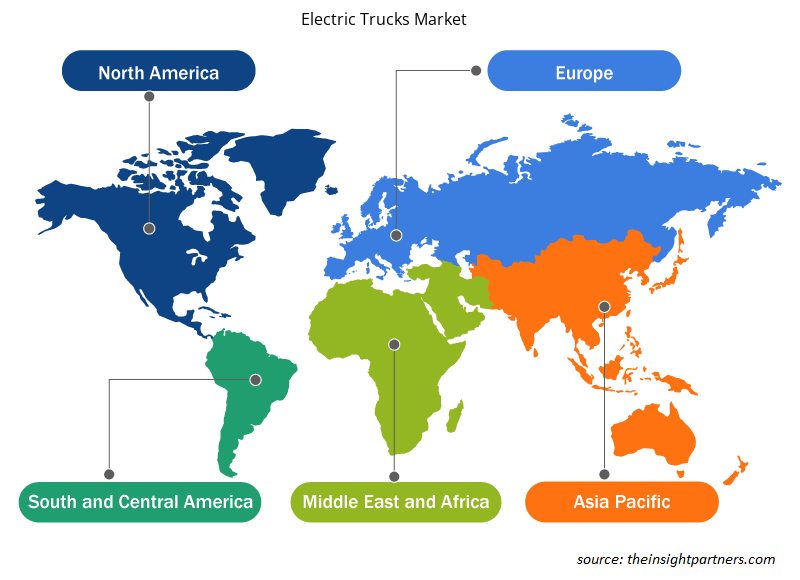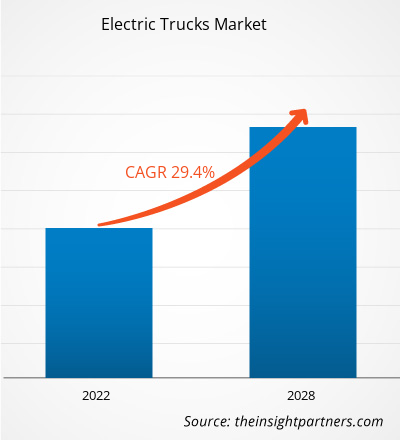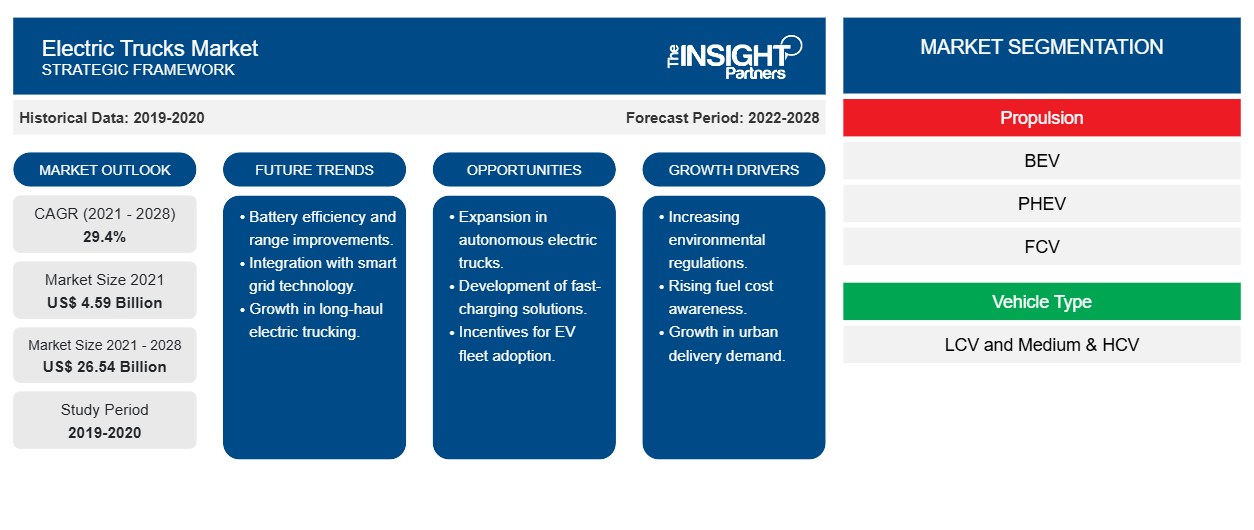電気トラック市場は、2021年の45億9,255万米ドルから2028年には265億4,290万米ドルに成長すると予想されており、2022年から2028年にかけて29.4%のCAGRで成長すると予測されています。
世界の自動車業界は、代替ソリューションやエネルギー消費量の少ないソリューションへの段階的な移行により、パラダイムシフトを遂げています。石油価格の高騰、汚染レベルの上昇、そして地球規模の気候変動に取り組むという国際的な誓約により、e-モビリティへの移行が加速しています。
電気トラック市場における最近の主な動向:
- 2021年8月、ボルボ・トラックは、江鈴汽車有限公司の子会社である江鈴重機重型車両有限公司の中国における大型トラック製造施設を買収しました。この買収には、中国山西省太原の生産施設も含まれます。目標は、2022年末までに太原で中国の顧客向けに新型大型トラック、ボルボFH、ボルボFM、ボルボFMXの製造を開始することです。
- 2021年9月、BYDはカリフォルニアのACT Expoで革新的なバッテリー電気大型トラック2台を発表しました。このトラックには先進運転支援システム(ADAS)が標準装備されており、運転がより簡単かつ安全になります。
推進力に基づいて、電気トラック市場はBEV、PHEV、FCEVに分類されます。2021年には、BEVセグメントが最大のシェアで市場をリードしました。車両に基づいて、電気トラック市場はLCV、中型およびHCVに分類されます。2021年には、LCVセグメントがより大きなシェアで市場をリードしました。航続距離に基づいて、電気トラック市場は200マイル未満と200マイル以上に分かれています。2021年には、200マイル以上のセグメントが市場で大きなシェアを占めました。自動化のレベルに基づいて、電気トラック市場は半自律型と完全自律型に分かれています。2021年には、半自律型セグメントが大きなシェアで市場をリードしました。地域別に見ると、電気トラック市場は主に北米、ヨーロッパ、アジア太平洋(APAC)、中東およびアフリカ(MEA)、南米(SAM)に分かれています。 2021年、ヨーロッパは市場の大きなシェアを占めた
要件に合わせてレポートをカスタマイズする
このレポートの一部、国レベルの分析、Excelデータパックなど、あらゆるレポートを無料でカスタマイズできます。また、スタートアップや大学向けのお得なオファーや割引もご利用いただけます。
- このレポートの主要な市場動向を入手してください。この無料サンプルには、市場動向から見積もりや予測に至るまでのデータ分析が含まれます。
COVID-19パンデミックが電気トラック市場に与える影響
2020年、COVID-19パンデミックは自動車生産の減少により電気トラック市場の成長を妨げました。COVID-19はさまざまな地域のEV市場にさまざまな程度の影響を与えました。多くのEV OEMは、社会的距離を置く傾向と購入時に混雑を避けたくない消費者に対応して、オンラインビジネスモデルと非接触型販売チャネルの構築を試みています。それにもかかわらず、COVID後の需要の急増により、2020年を通じて新しいEV工場の建設計画が設定されました。しかし、2020年の最初の3四半期では、COVID-19のため、新設されたEV工場のいずれも稼働しませんでした。
市場洞察 – 電気トラック市場
持続可能なモビリティの採用が増加
持続可能なモビリティの採用の増加により、要求が厳しく重量のある長距離輸送業務向けに、電気トラック(長距離バッテリー電気トラックや燃料電池電気トラックなど)やその他の電気車両の導入が促進されています。水素燃料電池を燃料とする電気トラックは、2022~2028年に利用可能になると予想されています。気候が輸送に与える影響を軽減するには、化石燃料から電気などの代替燃料への迅速な移行が必要です。その結果、ほとんどの輸送事業者は段階的に電気車両に移行する可能性があります。移行期間中、多くの事業者は異なる燃料を燃料とするトラックの混合車両を保有することになります。
電気自動車は、より効率的でクリーンな輸送を通じてエネルギーを節約し、国連が定めた持続可能な開発目標 (SDGs) を政府が達成することを可能にします。電気トラックは、他の電気自動車と同様に、排気ガスによる汚染の削減、化石燃料への依存の軽減、地域社会の健康の促進、エネルギー安全保障の提供、雇用とスキルアップの機会の改善に役立ちます。電気自動車の目標と再生可能エネルギーの目標を組み合わせることで、輸送業界の脱炭素化がさらに促進されます。欧州および発展途上地域の企業や政府機関は、EV 充電インフラを提供し、フリート車両を電気トラックに移行することで、世界の温室効果ガス排出量を削減し、電気トラックの採用を促進する上で大きな役割を果たす可能性があります。
推進力に基づく洞察
推進力に基づいて、電気トラック市場はBEV、FCV、PHEVに分類されます。BEVセグメントは2021年に最大の市場シェアを占めました。バッテリー駆動の電気トラックは、市場の成長に大きく貢献すると予想されています。ボルボやナビスターなどのメーカーは、自社の技術力を活用し、BEVの開発サイクルを短縮し、市場投入までの時間を短縮することに重点を置いています。バッテリー寿命とエネルギー密度の向上、およびバッテリー価格の低下により、BEVセグメントの電気トラック市場が拡大する可能性があります。
車両ベースの洞察
車両タイプに基づいて、電気トラック市場はLCVと中型およびHCVに分かれています。 LCVセグメントは2021年に大きな市場シェアで市場をリードしました。自動車メーカーと関連するパワートレイン部品サプライヤーは、電動でクリーンかつ持続可能な未来を受け入れています。初期段階から新しいパラダイムを作成することにより、いくつかのOEMはLCVプラットフォームを確立する従来の方法を変えています。多くの主要なOEMは、特定のeLCVプラットフォームを開発しています。一方、フリートマネージャーによる高度なカスタマイズの需要の高まりと、新しいサービスベースのモデルの導入は、LCV業界に利益をもたらしています。
範囲ベースの洞察
電気トラック市場は、航続距離に基づいて、200マイル未満と200マイル以上に分類されます。200マイル以上のセグメントは、2021年に大きなシェアで市場をリードしました。エンドユーザーの間で大きな好みがあるため、航続距離の長い商用車が世界市場を支配しています。
自動化に基づく洞察
自動化のレベルに基づいて、電気トラック市場は半自律型と完全自律型に分類されます。半自律型の電気トラックは市場で大きなシェアを占めています。しかし、あらゆる業界で自動化の採用が増え、自動運転トラックの完全な機能を可能にする技術が進化しているため、今後数年間は完全自律型のトラックが市場を支配すると予想されています。
電気トラック市場の地域別洞察
予測期間を通じて電気トラック市場に影響を与える地域的な傾向と要因は、Insight Partners のアナリストによって徹底的に説明されています。このセクションでは、北米、ヨーロッパ、アジア太平洋、中東、アフリカ、南米、中米にわたる電気トラック市場のセグメントと地理についても説明します。

- 電気トラック市場の地域別データを入手
電気トラック市場レポートの範囲
| レポート属性 | 詳細 |
|---|---|
| 2021年の市場規模 | 45億9000万米ドル |
| 2028年までの市場規模 | 265.4億米ドル |
| 世界のCAGR(2021年~2028年) | 29.4% |
| 履歴データ | 2019-2020 |
| 予測期間 | 2022-2028 |
| 対象セグメント | 推進力によって
|
| 対象地域と国 | 北米
|
| 市場リーダーと主要企業プロフィール |
|
市場プレーヤーの密度:ビジネスダイナミクスへの影響を理解する
電気トラック市場は、消費者の嗜好の変化、技術の進歩、製品の利点に対する認識の高まりなどの要因により、エンドユーザーの需要が高まり、急速に成長しています。需要が高まるにつれて、企業は提供を拡大し、消費者のニーズを満たすために革新し、新たなトレンドを活用し、市場の成長をさらに促進しています。
市場プレーヤー密度とは、特定の市場または業界内で活動している企業または会社の分布を指します。これは、特定の市場スペースに、その規模または総市場価値と比較して、どれだけの競合相手 (市場プレーヤー) が存在するかを示します。
電気トラック市場で事業を展開している主要企業は次のとおりです。
- ABボルボ
- BYD株式会社
- ダイムラーAG
- 一汽グループ株式会社
- ナビスター株式会社
免責事項:上記の企業は、特定の順序でランク付けされていません。

- 電気トラック市場のトップキープレーヤーの概要を入手
電気トラック市場レポートによると、市場で活動している企業は主に新製品の発売に重点を置いています。
- 2021 年初頭、ボルボ・トラックは新型ボルボ FM 電気トラック モデルを発表しました。新しい自動化機能を備えたこのモデルは、ドライバーの視認性が向上し、統合型電子制御ブレーキ システムを備えています。
- 2021 年 8 月、ナビスターは新しい完全電動国際 eMV シリーズ トラックの発売を発表しました。eMV トラックは、中型トラックの経験とゼロ排出を組み合わせ、完全に統合された電動パワートレイン ソリューションを提供するように設計されています。
- 過去2年間の分析、基準年、CAGRによる予測(7年間)
- PEST分析とSWOT分析
- 市場規模価値/数量 - 世界、地域、国
- 業界と競争環境
- Excel データセット
最新レポート
お客様の声
購入理由
- 情報に基づいた意思決定
- 市場動向の理解
- 競合分析
- 顧客インサイト
- 市場予測
- リスク軽減
- 戦略計画
- 投資の正当性
- 新興市場の特定
- マーケティング戦略の強化
- 業務効率の向上
- 規制動向への対応





















 無料サンプルを入手 - 電気トラック市場
無料サンプルを入手 - 電気トラック市場